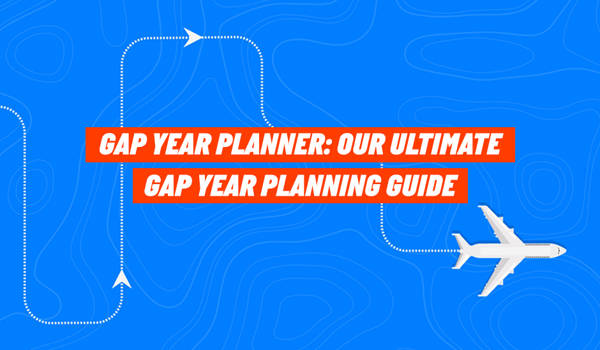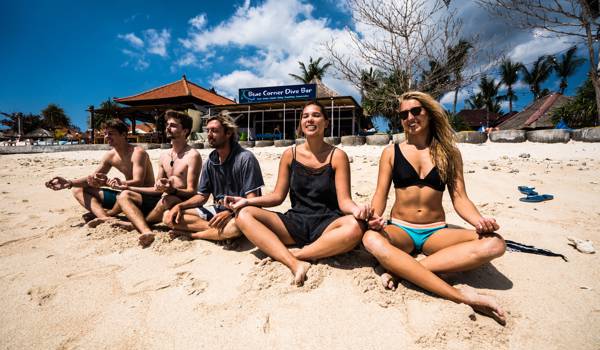Your complete gap year guide
Taking a gap year can be a transformative experience, offering young travellers the chance to explore new cultures, gain valuable skills, and enjoy a break from their usual routines.
This comprehensive guide provides step-by-step advice on planning a successful gap year, from setting clear goals and researching destinations to budgeting and choosing activities.
Whether you’re looking to volunteer, learn a new language, or simply travel independently, this guide covers everything you need to know to make the most of your time away. Start your adventure with confidence and make your gap year unforgettable.
Contents

Countdown to your gap year
Step 1: Identify Your Goals
Before you even start planning the logistics of your gap year, it's important to be clear on your goals - what do you want to achieve with this time out of work or study?
Do you want to gain valuable new skills to improve your career prospects?
Do you want to invest in your mental and physical well-being?
Do you want to earn some money and gain more work experience?
Or do you simply want to explore the world and enjoy a taste of freedom while you have a chance?
There are no right or wrong answers. This is your gap year and it's entirely up to you what you get out of it. But knowing what you want to get out of it will help you plan better. If you have a clear idea on your goals, you'll be able to pick the activities and experiences that will help you achieve those goals.
For example, if you want to boost your CV, you can plan to join a volunteer project. If you know you want to earn some money and experience life in another country, you can plan for a working holiday.

Step 2: Research Your Destinations
You don't have to travel during your gap year - you could stay home and work or volunteer. But as student, youth and adventure travel experts, we always think travelling is a good idea! In fact, at KILROY, we believe travelling the world and experiencing new cultures makes you a better person.
So we're going to assume you do want to travel during your gap year. And to start planning your trip, first you need to decide where you want to go.
You might already have a few countries on your travel wish list. Or you might be completely open to exploring places you're unfamiliar with.
Either way, it's wise to look at how much money you have to spend on your gap year and how far that can get you in each country or region.
To help, here's a quick overview of popular regions and a rough daily budget.
Southeast Asia
Aim for around £35/day to cover budget travel - staying in hostels, cooking your own meals and using local transport. If you want to include a few group tours and experiences like volunteering or diving, aim for £45-60 per day.
Latin America
Daily costs vary wildly depending on the country and the activities you want to include.
A shoestring budget of around £35/day will cover staying in hostels, cooking your own meals and using local transport in cheaper countries like Guatemala, Nicaragua, Bolivia and Colombia. Whack that up to around £45/day for more expensive countries like Costa Rica, Panama, Chile and Argentina.
If you want to include a few group tours and experiences like diving, trekking and volunteering, aim for £60-£90 per day.
Australia and New Zealand
A shoestring budget of around £35-50/day will cover staying in hostels, cooking your own meals and using local transport.
If you want to include a few group tours, hire a vehicle for a road trip, or take on adrenaline-pumping activities like skydiving, aim for £55-70 per day.
Africa
To travel around Africa, you're most likely going to join an overland camping safari with everything taken care of for you.
Depending on how many optional activities you want to do during your trip (like a hot air balloon ride or bungee jump), budget between £140-£180/day while on safari.
For volunteering, the cost goes down to anywhere between £50-£110/day depending on the type of project you choose.
Europe
Daily budgets can vary dramatically between the different regions of Europe. In Western Europe (countries like France and Germany), expect to spend around £50-£110 depending on your style of travel.
In Eastern Europe (countries like Poland and Hungary), this can go down to as low as £20-£60, whereas in Southern Europe (countries like Spain and Greece), you'll need to budget around £40-£80 a day.
If the Nordic countries are part of the plan, expensive countries like Norway and Denmark will require anywhere from £80-£200 a day.
Safety
While researching destinations for your gap year, it's sensible to check travel advisories for updates on safety. The Foreign, Commonwealth & Development Office is the best source of information for British citizens. Consult the FCDO Travel Advice website before booking your travel.

Best places to go on a gap year
Step 3: Choose Your Activities and Experiences
Once you've got an idea of where you want to go, start thinking about what you want to do while you're there.
The possibilities are endless! And once you arrive in your destination there will no doubt be a load more options to choose from that you hadn't even considered. But to help with budgeting and planning, it's a good idea to think about some of the more costly activities you might want to do.
Here are some options you might want to consider:
- Learn to dive - if you've ever wanted to explore the underwater world, get your PADI certificate and become a certified diver. There are many affordable diving schools around the world where you can learn to dive and you can easily add this experience to your travel itinerary.
- Go trekking - whether you want to conquer some of the world's most famous peaks or hike along famous trails to ancient cities, there are a number of popular treks that you could add to your plans. Some of our favourites include the Inca Trail Trek in Peru and the Mt. Kilimanjaro climb in Tanzania.
- Learn to surf - if you like the beach lifestyle and want to know how to catch a wave, join a surf camp and enjoy daily surf lessons on your gap year. This is a great option if you want to stay active while you travel and spend more time on the coast of a country.
- Learn a language - depending on which countries or region of the world you want to visit on your gap year, knowing the local lingo will help you navigate more confidently. With 20 countries speaking Spanish in Latin America, you'll get far with a bit of knowledge of Español. Join a local language school to brush up on Spanish vocabulary and grammar to help you get around and add to your CV at the same time.
- Volunteer - if you'd like to give back to the local communities of the countries you'll be visiting, consider volunteering your time and skills to a local volunteer project. It's a great way to become better acquainted with the social and environmental issues a country faces while helping to be part of the solution. It also makes your gap year more meaningful and will help with your future career prospects.
- Go skydiving or bungee jumping - your gap year is also a time to go a little wild and do things you've never done before. For a lot of young travellers, that means throwing themselves out of a plane or off the side of a bridge (with a parachute or bungee, of course!). These activities are on the pricier side, so if you do want to include some adrenaline action on your trip, factor that into your costs in advance.

Ideas to inspire your gap year
Step 4: Decide the Kind of Gap Year You Want
When it comes to gap year travel, there are a few different types you can choose from. Let's take a closer look at your options.
Independent Travel
If you prefer the flexibility and freedom to design your travel itinerary as you go, independent travel is the way to go. This usually means packing your belongings in a large backpack, using local transport to get around, staying in hostels and cooking your own meals, and planning your next steps on the fly.
Backpacking is a great way to gain independence while keeping costs down as you travel. It's also a good way to meet other travellers, as hostels are a sociable accommodation option that attracts other like-minded backpackers.
Independent travel might also include a road trip with car or campervan hire to cover your transport, and even accommodation all in one. Again, you get to decide where you go and when, and how long you stay for.
This style of travel is a great option if you're already an experienced traveller or if you're a beginner that feels confident in organising your own travel arrangements.
However, not everyone has travelled before nor feels confident planning a big trip. Which is where the second option comes in.
Structured Programs
If you're the kind of person who likes to have things organised in advance, enjoys a schedule or just wants the reassurance of booking pre-arranged services, a structured gap year program is a better option for you.
With these types of programs, your flights, activities and accommodation are all sorted. You'll have a complete itinerary with people on hand to help you through the entire process - from planning to booking, and ultimately travelling.
We offer two different options for structured gap year programs:
- Gap Year Travel Programs - these flexible and customisable packages combine international flights with group tours to help you explore the world with other young travellers. You won't need to worry about booking your own travel arrangements, as most services are included - like accommodation, some meals, local transport and different activities.
- Gap Year Volunteer Programs - if you want to give back to local communities or learn new skills to help with your future career, these packages combine some of our most popular volunteer projects with group tours so that you get to explore the country where you volunteer. Again, everything is included and arranged for you, so you don't have to worry about planning by yourself.
Combination of Both
Perhaps the best option for most travellers is a combination of independent travel and a structured program.
You could start with a volunteer project, a group tour or even a working holiday arrival package to help you acclimatise to life in another part of the world. You'd be surrounded by people of a similar age on a similar adventure to you. And you'd have your own personal travel advisor on hand to help if anything goes wrong.
Once you've gained a bit of confidence, you can set out on your own and backpack for the remainder of your trip. Combining these two styles of gap year travel really is the best of both worlds.
Step 5: Start Budgeting
Once you've picked where you want to go and have a rough idea of how much money you'll need to travel around these destinations, it's time to start budgeting.
Estimate your costs
First, estimate the full cost of your gap year. As well as having a rough idea of daily budgets, you should also allocate budget to the following:
- Flights
- Travel insurance
- Visas
- Travel gear (backpack, hiking shoes, outdoor clothing, etc.)
You can use websites like Skyscanner to get an idea of flight prices, or sites like Compare the Market for quotes on travel insurance. You can also check the official government websites for your chosen destinations to check the costs of visas.
Alternatively, if you book your gap year adventure with KILROY, we can provide you with a complete package that includes flights and travel insurance, so you know exactly how much you'll need to budget for your trip.
Save money
Now that you know how much money you need for your gap year, it's time to start putting money aside to fund it. If you don't already have a part-time job, consider getting one. Depending on your study schedule at school, college or university, you can work weekends or evenings to pick up some extra cash.
Put as much money as you can aside into a savings account. Check Money Saving Expert for the latest advice on the best saving accounts.
If you have a load of stuff that you rarely use, consider flogging it on a site like eBay or Vinted. You could make a few extra quid from selling unwanted clothes (in good condition, of course) or electrical items.
Look for travel deals
With a plan in place of where you want to go, you can keep an eye out for deals on flights, tours and accommodation.
Depending on how far in advance you're booking your gap year travel, you can try and time when you book with peak sale periods. January is a great time to book, as many travel companies start the year with discounts. November can also be a good time to book, as some travel brands run a sale during the Black Friday period.
Sign up for our newsletter and you'll be the first to hear about our latest discounts and offers. Or speak to our team of gap year travel experts who can guide you on the cheaper times to travel and routes to follow to help save money on your trip.

How to budget for a gap year
Step 6: Prepare the Logistics
Choosing where you want to go and what you want to do is the fun part of planning how to take a gap year. But there are some boring - yet vital - logistics that you need to prepare for. Let's take a look at what those are.
Visas and Documentation
First thing first - make sure you have a valid passport with enough time still left before it expires.
You will need a good six months from the date you plan to return home. That's because many countries require you to have at least six months validity on your passport before granting a visa.
If you plan on doing a working holiday abroad, you might need as many as four years validity on your passport, as some of these visas can last up to three years.
The next step is to check the visa requirements for every country you plan to visit. If you need to apply for a visa before entering the country, make sure you do so well in advance. The FCDO website is a good resource for this.
Health and Safety
Next, check what vaccinations you need. The NHS Fit to Travel website provides up-to-date information on vaccinations that are either required or recommended. You could also book an appointment with your GP or a dedicated travel health clinic to discuss vaccinations.
Again, allow plenty of time to get this sorted, as some vaccinations are administered over a period of a few weeks and, in some cases, months.
Make sure you have emergency contacts to hand while you're travelling too. This should include the emergency contact of your travel insurance provider and perhaps a healthcare professional or organisation here in the UK that you can call while you're travelling and need advice.
Packing
Start by writing a list of all the things you think you'll need during your time away. This should cover everything from clothes to toiletries, electronics to medicines. Make a note of what you already have, what you need to buy before you leave, and what you can buy or top up while you're travelling.
It's always a good idea to pack your bag a few times before you leave. This way you can play around with what goes where to make it easier to unpack and repack (which, trust us, you'll be doing often!). Aim to have your main backpack 80-90% full so that you have space to add items once you're on the road.
Step 7: Stay Connected
Before you set out on your gap year adventure, give some thought as to how you plan to stay connected throughout your journey.
Communication
You won't always have access to WiFi while you're travelling, but we bet you'll always want to be able to speak with or message your friends and family back home. So it's worthwhile looking into buying an international SIM card for access to data wherever you go. Or consider buying local SIM cards in each country - this could be a cheaper option depending on how many countries you plan to visit and how long you'll be in each.
Your parents are going to worry about you, no matter what you do (it's their job, after all!). To help alleviate some of their concerns, make a plan to check in with them on a regular basis. Keep them informed of your itinerary so that they know where you are and where you're going to be next.
Schedule regular calls to share your travel stories and keep in the loop with what's going on back home.
Travel Apps
These days there's an app for everything you could possible think of! But here are some of our favourite for gap year travel:
- TravelSpend: This app helps you track your expenses and manage your budget. You can categorise your spending, set daily budgets, and see where your money is going.
- Google Maps: Essential for navigation, Google Maps provides detailed maps, directions, and information about local businesses and attractions. You can also download maps for offline use.
- Rome2rio: This app helps you find the best ways to get from one place to another, whether by plane, train, bus, ferry, or car. It provides detailed route information and cost estimates.
- Hostelworld: Perfect for finding budget accommodation, Hostelworld allows you to search for and book hostels around the world. It includes reviews, ratings, and detailed descriptions of each property.
- Duolingo: If you're travelling to a country where you don't speak the language, Duolingo is a great app for learning the basics. It offers fun, interactive lessons in many languages.
Further Reading
Check out our complete gap year travel guide with these additional resources:

